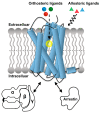G Protein-coupled Receptor (GPCR) Reconstitution and Labeling for Solution Nuclear Magnetic Resonance (NMR) Studies of the Structural Basis of Transmembrane Signaling
- PMID: 35566006
- PMCID: PMC9101874
- DOI: 10.3390/molecules27092658
G Protein-coupled Receptor (GPCR) Reconstitution and Labeling for Solution Nuclear Magnetic Resonance (NMR) Studies of the Structural Basis of Transmembrane Signaling
Abstract
G protein-coupled receptors (GPCRs) are a large membrane protein family found in higher organisms, including the human body. GPCRs mediate cellular responses to diverse extracellular stimuli and thus control key physiological functions, which makes them important targets for drug design. Signaling by GPCRs is related to the structure and dynamics of these proteins, which are modulated by extrinsic ligands as well as by intracellular binding partners such as G proteins and arrestins. Here, we review some basics of using nuclear magnetic resonance (NMR) spectroscopy in solution for the characterization of GPCR conformations and intermolecular interactions that relate to transmembrane signaling.
Keywords: 19F-NMR; G protein-coupled receptors; amino-acid-specific NMR labeling; in-membrane chemical modification; membrane mimetics; sequence-specific NMR labeling; stable-isotope labeling.
Conflict of interest statement
The authors declare no conflict of interest.
Figures






Similar articles
-
GPCR structural characterization by NMR spectroscopy in solution.Acta Biochim Biophys Sin (Shanghai). 2022 Aug 25;54(9):1207-1212. doi: 10.3724/abbs.2022106. Acta Biochim Biophys Sin (Shanghai). 2022. PMID: 36017890 Free PMC article. Review.
-
Solution NMR spectroscopy of GPCRs: Residue-specific labeling strategies with a focus on 13C-methyl methionine labeling of the atypical chemokine receptor ACKR3.Methods Cell Biol. 2019;149:259-288. doi: 10.1016/bs.mcb.2018.09.004. Epub 2018 Nov 15. Methods Cell Biol. 2019. PMID: 30616824 Free PMC article.
-
Magic angle spinning NMR of G protein-coupled receptors.Prog Nucl Magn Reson Spectrosc. 2022 Feb;128:25-43. doi: 10.1016/j.pnmrs.2021.10.002. Epub 2021 Nov 1. Prog Nucl Magn Reson Spectrosc. 2022. PMID: 35282868 Free PMC article. Review.
-
Production of a Human Histamine Receptor for NMR Spectroscopy in Aqueous Solutions.Biomolecules. 2021 Apr 24;11(5):632. doi: 10.3390/biom11050632. Biomolecules. 2021. PMID: 33923140 Free PMC article.
-
Design and preparation of the class B G protein-coupled receptors GLP-1R and GCGR for 19 F-NMR studies in solution.FEBS J. 2021 Jul;288(13):4053-4063. doi: 10.1111/febs.15686. Epub 2021 Jan 9. FEBS J. 2021. PMID: 33369025
Cited by
-
Selective polypeptide ligand binding to the extracellular surface of the transmembrane domains of the class B GPCRs GLP-1R and GCGR.iScience. 2023 May 19;26(6):106918. doi: 10.1016/j.isci.2023.106918. eCollection 2023 Jun 16. iScience. 2023. PMID: 37332600 Free PMC article.
-
Two-Dimensional NMR Spectroscopy of the G Protein-Coupled Receptor A2AAR in Lipid Nanodiscs.Molecules. 2023 Jul 14;28(14):5419. doi: 10.3390/molecules28145419. Molecules. 2023. PMID: 37513291 Free PMC article.
-
Probing the Conformational Space of the Cannabinoid Receptor 2 and a Systematic Investigation of DNP-Enhanced MAS NMR Spectroscopy of Proteins in Detergent Micelles.ACS Omega. 2023 Aug 28;8(36):32963-32976. doi: 10.1021/acsomega.3c04681. eCollection 2023 Sep 12. ACS Omega. 2023. PMID: 37720784 Free PMC article.
References
Publication types
MeSH terms
Substances
Grants and funding
LinkOut - more resources
Full Text Sources

